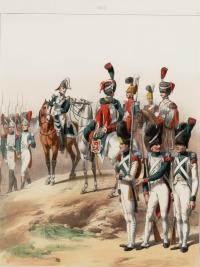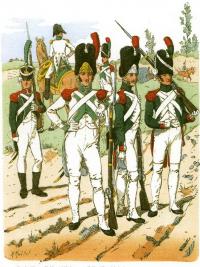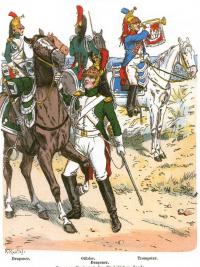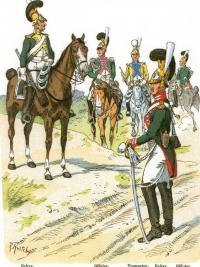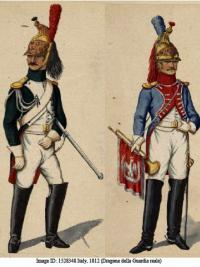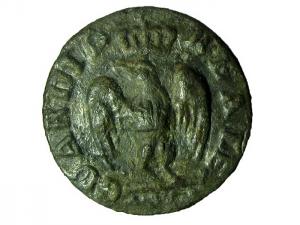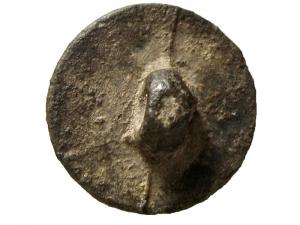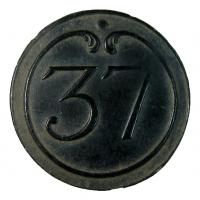Королевство Италия Гвардия - The Royal Guard of Italy.
Королевство Италия Гвардия.
Итальянское королевство образованное из Ломбардии, Циспаданской и Цизапильских республик берёт начало 17 марта 1805 года. Через 2 месяца 26 мая 1805 года в Милане, Железной короной Ломбардии короновали Наполеона. После окончания войны с Австрией, по Пресбургскому мирному договору к королевству Италия присоединили Венецианскую республику и Южный Тироль. Евгений Богарне, пасынок Наполеона получил титул вице-короля Италии. Заботой вице-короля стала реорганизация армии. В национальном архиве Парижа есть записка о состоянии армии:
Guardia del Presidente - Президентская гвардия- пехота,кавалерия,артиллерия.
Fanteria di Linea - линейная пехота- 5 полков.
Fanteria di Leggera - лёгкая пехота - 2-а полка.
Legione Italiano - пехотная часть,вспомогательный полк.
Cacaciatori a Cavallo - конные егеря - 1 полк.
гусары - 2-а полка.
Артиллерийский корпус.
Инженерный корпус.
Gendarmeria nazionale - национальная жандармерия - 2-а полка.
Invalidi e veterani - инвалиды и ветераны - один батальон.
Батальон береговой артиллерии.
Польские один пехотный и один кавалерийский полк состоявшие на итальянской службе в 1806 году были переданы в армию Неаполитанского королевства.
К концу 1805 года, в основном, из итальянцев были сформированы части, которые заложили основу всей армии.
Королевская гвардия:
корпус Почётной королевской гвардии, 4-ре роты кавалерии - Guardia Reale d'Onore;
корпус Королевских велитов, - 12 рот - Veliti reale;
корпус линейной гвардии - Guardia di Linea- состоящий из:
-- пехотного полка линейной гвардии с Гвардейским гренадерским - Grenatieri a Piedi- и Гвардейским егерьским - Cacciatori a Piedi - батальонами.
-- одного полка конных драгун - Dragoni della Guardia Reale;
-- одной роты конной Гвардейской артиллерии;
-- одного батальона Брешиарских егерей, - Cacciatori de Bresc.
В ходе различных преобразований и нововведений к 1808 году гвардия имела в своём составе:
Пехотный полк линейной гвардии. Он состоял:
-- из одного гренадерского батальона, в нём было 5 рот по 105 человек в роте.
-- из одного егерьского батальона, в нём было 5 рот по 105 человек в каждой.
Велиты, - 3 батальона по 5 рот, состоящих из 120 человек каждая.
Морская рота состоящая из 60 человек.
Пешая артиллерия - 1 рота состоящая из 8-ми трофейных австрийских 6-ти фунтовых орудий.
Конная артиллерия - 1 рота состоящая из 8-ми трофейных австрийских 6-ти фунтовых орудий.
Драгуны - 2-а эскадрона по 2 - е роты, состоящие из 104 человек каждая.
Королевская Почётная Гвардия - 5 рот по 108 человек в роте.
1-а рота элитных жандармов - 43 человека.
Следующие преобразования наступили в армии Итальянского Королевства в 1810 году. Три батальона велитов объединили в 2 - а основных гвардейских полка, причём, 1 из рот стала гренадерской, а две другие - егерьскими. Чуть позже егерьские роты переименовали в карабинерные.
Количество батальонов велитов было сокращено с 3-х до 2-х. Один гренадерский и второй карабинерный. Был переименован егерьский полк линейной гвардии, он стал именоваться - карабинерным.
Роты полковой артиллерии получили полки велитов,линейной гвардии и конскриптов. Также им был придан артиллерийский обоз.
Нововведения коснулись и гвардейских моряков, они были объединены в один экипаж , в котором было 152 человека, а также в роту пешей артиллерии - 100 человек.
Командовать Четвёртым армейским корпусом Великой Армии в Русской компании было поручено вице-королю Итальянского Королевства, пасынку Наполеона, сыну Жозефины - Евгению Богарне.
Командир: дивизионный генерал граф Доменико Пино (Pino), премьер-капитан Королевской гвардии, командир 15-й пехотной дивизии.
Командующий: бригадный генерал барон Теодоро Леки (Lecchi), командующий пехотной бригадой Королевской гвардии.
Начальник штаба: капитан Бадаласси (Badalassi).
Младший инспектор смотров: Бельфор (Belfort).
Военные комиссары: Жини (Gini), Форти (Fortis).
В русской Компании по данным на 25 июня 1812 года она подразделялась на :
-- Пехотную бригаду гвардии:
Командир: бригадный генерал барон Теодоро Леки (Lecchi).
Адъютант: капитан Миглиорини (Migliorini).
-- полк Королевских велитов, - 43 офицера и 1105 нижних чинов.
Командир: полковник Пьетро Анжело Морони (Moroni).
Батальон гренадер: шеф батальона Бастид (Bastides).
Батальон карабинеров: шеф батальона Маффе (Maffee).
Рота полковой артиллерии: две 6-фунтовых пушки.
Всего: 2 батальона, 2 орудия.
До Русской Компании полк сражался, Эль-Брюхо, Матаро, Герона, Пьяве, Рааб, Ваграм.
В походе 1812 года часть прошла всю Компанию и сражалась в Малоярославеце, Вязьме, Духовщине, Красном.
После 1812 года - Сан-Марко, Волано.
-- Гвардейский карабинерный пехотный полк , - 45 офицеров и 1137 нижних чинов.
Командующий: 2-й полковник Крови (Crovi).
Батальон гренадер: шеф батальона Сакини (Sacchini).
Батальон егерей: шеф батальона Бонфанти (Bonfanti).
Рота полковой артиллерии: две 6-фунтовых пушки.
Всего: 2 батальона, 2 орудия.
До Русской Компании полк сражался: Соава, Кастельчерино, Пьяве, Рааб, Ваграм.
В походе 1812 года часть прошла всю Компанию и сражался в Малоярославеце, Вязьме, Духовщине, Красном.
После 1812 года - Сан-Марко, Волано, Фейстриц, Вейзельбург, Чернуц.
-- Гвардейский полк конскриптов,- 40 офицеров и 1084 нижних чина. Командир:
Полковник Ольвье Антуан Константен Перальди (Peraldi).
Батальон гренадер: шеф батальона Казимо Дель Фанте (Del Fante).
Батальон егерей: шеф батальона Сюбервиль.
Рота полковой артиллерии: 2 6-фунтовых пушки.
Всего: 2 батальона, 2 орудия.
В походе 1812 года часть прошла всю Компанию и сражалась в Малоярославеце, Вязьме, Духовщине, Красном.
Итальянский корпус под командой Евгения Богарне перешёл через реку Нёман 30 июня 1812 года у местечка Прены.
20 июля в Сураже в ее рядах корпуса – 5300 чел., перед выступлением от Смоленска к Москве – 6600 тыс. чел., под Гжатском – 4100 чел. при 18-ти орудиях (2600 чел. пехоты и 940 чел. кавалерии).
При отступлении к Смоленску Итальянская королевская гвардия сражалась под Вязьмой, в боях 4 ноября при Красном понесла чувствительный урон. Ее остатки 17 ноября переправились через р. Березина и 30 ноября покинули пределы России, перейдя Неман у Ковно.
Пройдя всю компанию, участвуя в различных сражениях, испытывая все тяготы отступления корпус сохранил достаточный порядок и организованность.
12 декабря 1812 года остатки корпуса Итальянского Королевства сумели перейти границу Российской Империи около Ковно.
31 декабря 1812 года только 452 человека собрались в Мариенвердере из всего корпуса. По другим данным собралось 112 офицеров и 149 солдат и унтер-офицеров.
После окончания Русской Компании в армии опять прошли перемены. В январе 1813 года Гвардейский пехотный полк переименовали в Гвардейских гренадер. Конскриптов переименовали в Гвардейских егерей.
В обоих новых полках количество батальонов сократили до 2-х батальонов. Но к марту количество батальонов в егерьском полку увеличили до 4-х. Почётная гвардия сократилась до 1-й роты.
The Royal Guard of Italy.
The Kingdom of Italy was formed from Lombardy, Tsispadanskaya and Tsizapilskaya republics on March 17, 1805. In 2 months, on May 26, 1805 in Milan, Napoleon was crowned with the Iron Crown of Lombardy.
After the war with Austria, the Republic of Venice and South Tyrol were annexed to the Kingdom of Italy by the Pressburg Peace Treaty. Eugene de Beauharnais, Napoleon's stepson received the title of Viceroy of Italy. The primary duty of viceroy was the reorganization of the army. At the National Archives in Paris there is a note about the state of the army:
Guardia del Presidente – the Presidential guard - infantry, cavalry, and artillery;
Fanteria di Linea - the line infantry - 5 regiments;
Fanteria di Leggera – the Light infantry - 2 regiments;
Legione Italiano – the infantry unit, an auxiliary regiment;
Cacaciatori a Cavallo - horse huntsman’ regiment - 1 regiment;
The Hussars – 2 regiments;
The Artillery Corps;
The Corps of Engineers;
Gendarmeria nazionale - the National Gendarmerie - 2 regiments;
Invalidi e veterani – the invalids and veterans - one battalion;
The Battalion of the Coast Artillery.
Polish infantry (1) and cavalry (1) regiments that were in the Italian service were transferred to the army of the Kingdom of Naples in 1806.
By the end of 1805, there were formed parts, which laid the foundation of the entire army. They were formed mainly from the Italians.
The Royal Guard:
The Honour Corps of the Royal Guard, 4 cavalry companies - Guardia Reale d'Onore;
The Corps of the Royal Bids (velites) - 12 companies - Veliti reale;
The corps of the line Guard - Guardia di Linea- which was consisting of:
- The line Infantry, the Guard Grenadier - Grenatieri a Piedi- and the Guard huntsmen - Cacciatori a Piedi - battalions.
- One regiment of mounted dragoons - Dragoni della Guardia Reale;
- One company of Mounted Guards artillery;
- One battalion of Breshiar huntsmen, - Cacciatori de Bresc.
During various changes and innovations to the 1808 the Guard had in its composition:
The Infantry of the line Guard. There was one grenadier battalion. There were 5 regiments with 105 people in each of them.
One huntsmen’s Battalion. There were 5 companies with 105 people in each.
The Bids (velites). Three Battalions were consisted of 5 regiments with 120 people in each.
The Marine squadron consisting of 60 people.
The Walking artillery - 1 company that was consisted of 8 captured Austrian 6-pound guns.
The Horse Artillery - 1 company that was consists of 8 captured Austrian 6-pound guns.
The Dragoons - 2 squadrons and 2 companies that were consisted of 104 people in each.
The honor Royal Guard - 5 regiments with 108 people in each.
One squadron of elite gendarmes - 43 people.
The next transformations appeared in the army of the Kingdom of Italy in 1810. Three battalions of Bids (velites) were joined in 2 major Guards regiments. One of these battalions became a grenadier, and two others - huntsmen. A little bit later the huntsmen battalions were renamed into Carabinier.
The number of Bids battalions was reduced from 3 to 2. One of them was the Grenadier and another one was the Carabinier. The huntsmen’s regiment was renamed into the line Guard, and it became known as the Carabinier.
The companies of artillery received the regiments of Bids, of the line Guard and of the Konscripts. They also got an artillery convoy.
Innovations had touched the Guards sailors too. They were combined into one crew, which had 152 people, as well as into a company of foot artillery where 100 people were.
The commanding of the Fourth Army Corps of the Grand Army in the Russian Campaign was entrusted to the Viceroy of the Italian Kingdom, stepson of Napoleon, Josephine's son - Eugene Beauharnais.
Commander: Major-General Count Domenico Pino (Pino), Prime Captain of the Royal Guard, the commander of the 15th Infantry Division.
Commander: Brigadier General Baron Teodoro Leckie (Lecchi), commander of an infantry brigade of the Royal Guard.
Chief of Staff: Captain Badalassi (Badalassi).
Junior Inspector Looks: Belfort (Belfort).
Military commissars: Gini (Gini), Forti (Fortis).
In the Russian Campaign by June 25, 1812, it was divided into:
- The Guard brigades of infantry:
Commander: Brigadier General Baron Teodoro Leckie (Lecchi).
Adjutant: Captain Migliorini (Migliorini).
- The Royal Regiment of Bids – there were 43 officers and 1105 established men.
Commander: Colonel Pietro Angelo Moroni (Moroni).
Grenadier battalion: Battalion Chief Bastide (Bastides).
Carabinieri Battalion: Battalion Chief Maffei (Maffee).
Roth regimental artillery: two 6-pounders.
Total: 2 Battalion, 2 guns.
Before the Russian Campaign the regiment had fought in El belly, Mataro, Gerona, Piave, Raab and Wagram.
In March 1812 the entire company took part in fights in Maloyaroslavets, Vyazma Dukhovshchina, Krasnoye.
After 1812 they fought in San Marco and Volano.
- The Guard Regiment of Carabinier Infantry – there were 45 officers and 1137 established men.
Commander: 2nd Colonel Blood (Crovi).
Grenadier battalion: Battalion Chief Sakina (Sacchini).
Jaegers Battalion: Battalion Chief Bonfanti (Bonfanti).
Roth regimental artillery: two 6-pounders.
Total: 2 Battalion, 2 guns.
Before the Russian Campaign the regiment had fought in Soave, Kastelcherino, Piave, Raab and Wagram.
In March 1812 the entire regiment took part and fought in Maloyaroslavets, Vyazma Dukhovshchina, Krasnoye.
After 1812 they fought in San Marco, Volano, Feystrits, Veyzelburg, Chernuts.
- The Guard Regiment of the Konskripts – there were 40 officers and 1084 established men.
Colonel Antoine Constant Olve Peraldi (Peraldi).
Grenader battalion: Battalion chief Kazim Del Fante (Del Fante).
Egerej battalion: Battalion chief Sûbervilʹ.
Rota polkovoj Artillery: 2 6-funtovyh rifle.
Total: 2 Battalion, 2 Seeding.
The Italian corps that was under the command of Eugene Beauharnais crossed the Neman River on June 30, 1812 in the village of Prena.
July 20 Surazh in its ranks housing - 5300 people., Before the performance from Smolensk to Moscow - 6600 thousand. Pers., Under Gzhatsk - 4100 people. with 18 guns (2600 people. infantry and 940 people. cavalry).
During the retreat to Smolensk Italian Royal Guard fought at Vyazma in battle on November 4 at the Red sensitive suffered damage. Her remains of 17 November crossed the river. Berezina and 30 November left Russia clicking Neman at Kovno.
Passing the whole Campaign, participating in various battles, experiencing all the hardships retreat the corps retain orderliness and organization.
On December 12, 1812 the remains of the corps of the Italian Kingdom were able to cross the border of the Russian Empire near Kovno.
On December 31, 1812 there were only 452 people of the entire body who gathered in Marienwerder. According to other data gathered 112 officers and 149 soldiers and non-commissioned officers.
After the end of the Russian Campaign the changes in the army happened again. In January 1813 the Guard regiment of infantry was renamed as the Guard Grenadiers. Konskripts were renamed as Guards rangers.
The number of battalions was reduced to 2 battalions in both new regiments. But by March, the number of battalions in the regiment of huntsmen was increased to 4. The guard of Honor was reduced to the 1st company.
There is currently no content classified with this term.
Social

